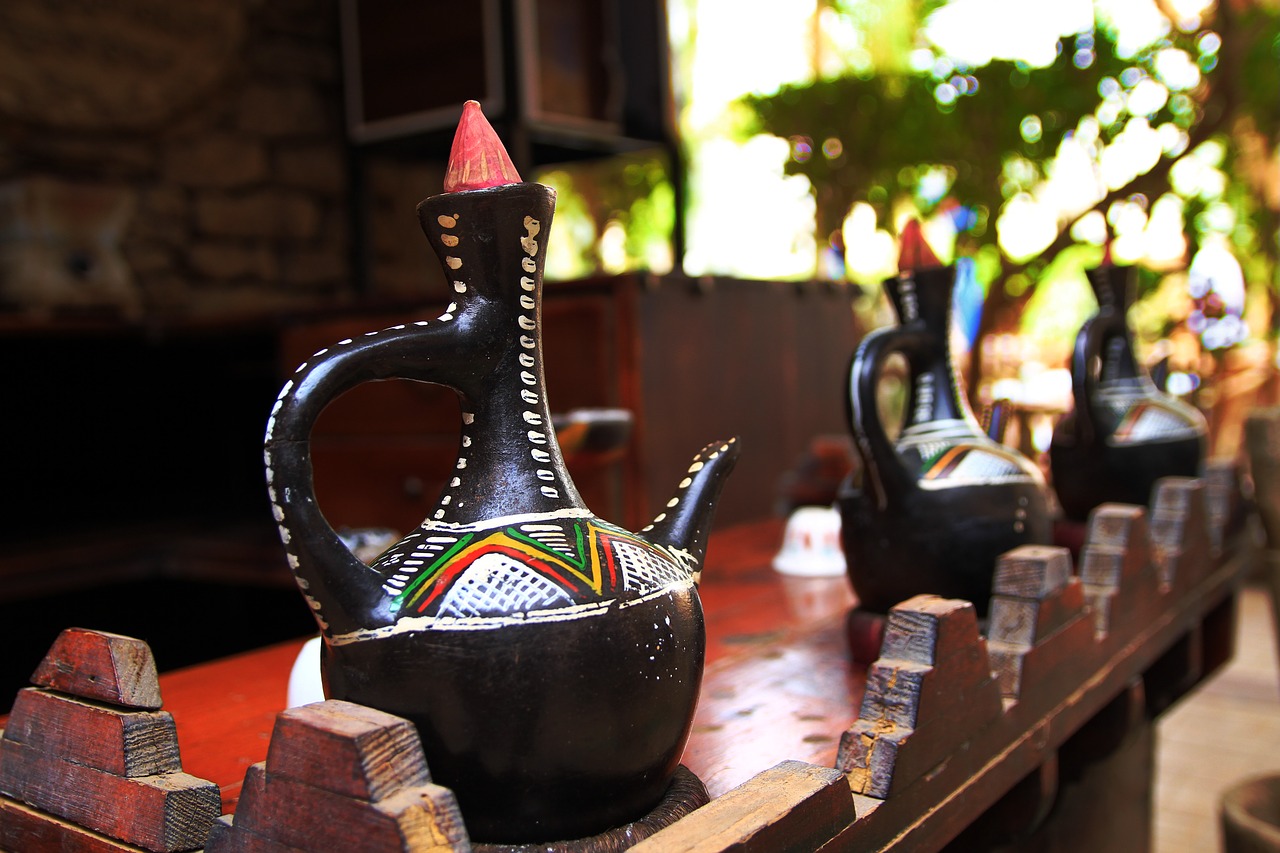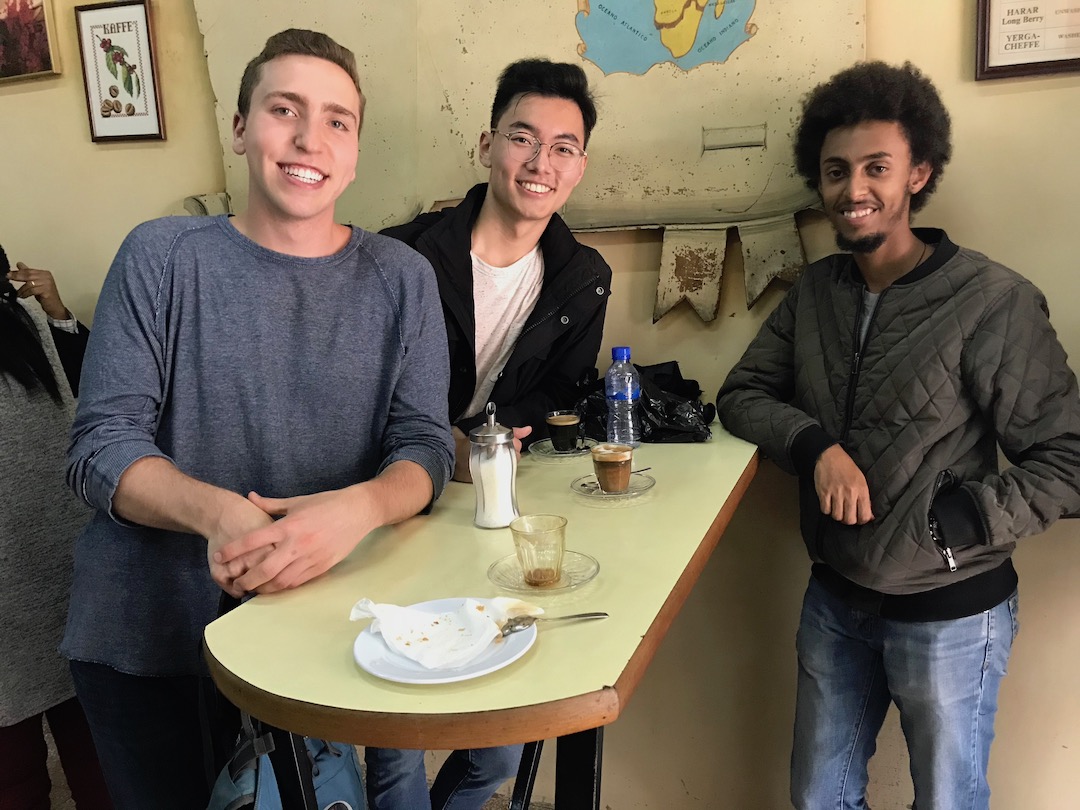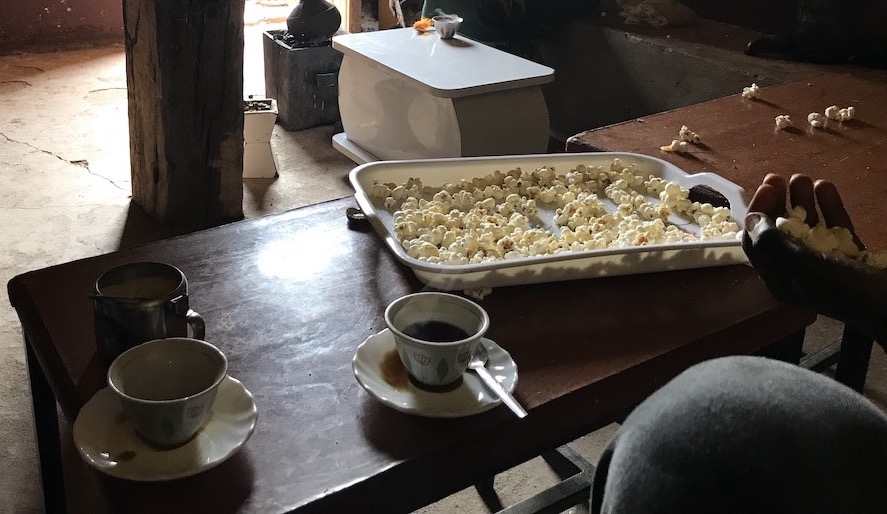Coffea Ethiopica ☕️
Published August 23, 2019, Page Last Modified June 27, 2023
[The information in this piece comes from personal experience in Addis Ababa and the Tigray region. Thank you Natnael Habtamu and Rövël Gøí for reviewing drafts of this piece.]
The worst crime an Ethiopian child can commit is breaking their family’s jebena. Okay, maybe not the worst crime. But breaking your mom’s jebena is pretty high up there.
A jebena (ጀበና) is a traditional Ethiopian clay pot used for brewing coffee. In Ethiopia, they’re everywhere! They come in different sizes, have different patterns and engravings, and are central to the daily life of most Ethiopians.

But the jebena doesn’t derive its value from being a dormant centerpiece. Its true value comes from its ability to turn roasted beans into the dark, rich, luscious, brew that we call coffee, or in Amharic, bunna (ቡና).
Ethiopia produces 350 million kg of coffee every year (1, a, 2, a). The best of the beans are exported out of the country because the Ethiopian government wants to bring in the most foreign currency it can. The worst of the crop (with some exceptions) is left to the 100 million Ethiopians where the beans originally came from. Yet despite this, the coffee I’ve enjoyed in Ethiopia is still tastier than the coffee I drink in America. The attention and care given to coffee here is extraordinary and makes every cup delicious.
And when I say “where the beans originally came from,” I do mean originally. The Ethiopian province of Kaffa (same etymology as the word coffee!), is the home of the species Coffea arabica, the coffee plant that has spread around the globe to Hawaii, Costa Rica, Colombia, Indonesia, and dozens of other regions.
But, you will not find Starbucks in Ethiopia. Starbucks wouldn’t survive here. While a Grande coffee at a Starbucks in America costs about $2.10, a cup of coffee in Addis costs about 5 birr, or 17 cents. Even at a more high-end coffee shop in Addis, like Tomoca or Kaldi’s, drinks still sell for between 10 and 40 birr (34 cents to $1.36). There also aren’t 50 different coffee beverages to choose from in Ethiopia. There’s usually just the choice between a coffee, latte, cappuccino, and macchiato. It seems like the current supply of iced coffee is zero! (Though, the demand might be zero too 😶).


In Ethiopia, everything starts with coffee. Including the day itself.
Most Ethiopians start their morning with a cup. But more typically, three. This occurs at the first coffee ceremony of the day.
At a coffee ceremony, the coffee-maker (usually a woman), will start by preparing a small charcoal fire. She’ll scatter handfuls of raw, green coffee beans into a pan and place the pan over the heat. As the pan gets hotter and hotter, the raw beans begin to pop and crackle, evolving from their muddy green to a dark, shiny black. Along with the sounds of the coffee roasting, the fragrances of the cooking beans begin to fill the surrounding air, inviting all who are nearby to come and stay along for the rest of the ride.
Once the beans are fully roasted, the coffee-maker will remove them from the pan, drop them into a mortar, and ground them up by pestle in hand. Hot water and the roasted grounds are emptied into the jebena. The jebena then sits over the fire for a few minutes where the two-ingredient concoction boils and mixes. Multiple times, the brew boils and rises out through the spout of the jebena. Any boiling coffee foam that leaks from the top instantly evaporates on the surface of the hot clay spout. When this happens, the coffee-maker lifts the jebena off the flames, pours some of the boiling coffee out into a separate cup, cooling it with the air, and then pours the coffee right back into the jebena. After a short moment, the coffee-maker will place the jebena back on the searing, orange and white charcoals. She will continue this process of heating and cooling until the coffee is clear and finished brewing.
Finally, the coffee is poured into small symmetrical cups until each cup is practically overflowing. Each guest of the ceremony takes a full cup. Some drink it black. Some add one or two spoonfuls of sugar (which is one of the few times I’ve seen sugar used in Ethiopian cuisine). Many stir in a green herb called tena’adam (Ruta graveolens) into their coffee to add some extra bitter flavor as well as for health reasons. The coffee is strong, and you can feel the caffeine from the first cup hit after a few sips. Along with the coffee, there’s usually a light snack such as roasted barley, known as kolo (ቆሎ), or popcorn, which is often sprinkled with some sugar too.

After everyone finishes their first cup (abol), a second round (tona) is poured. And finally, after this second cup, a third (bereka). With each new cup, the intensity of the coffee decreases slightly as the grounds get more and more of their flavor used up.
It’s common for this coffee ceremony to take place 3 times each day (morning, midday, and night). Which means 9 cups of coffee for those who drink! Granted, the cups are small (about 4-5 oz.), but still quite a lot of bunna! While I personally avoid drinking coffee at night, I’ve been told by a local friend that, “a good coffee doesn’t interrupt sleep.”
In rural areas, girls will begin learning how to perform a coffee ceremony as young as 7 or 8 years old. And the coffee ceremony will remain as an important honor throughout her life. It might even play a role in helping her start a family.
Sometimes, when a young man and young woman are dating and thinking of marrying, the young man’s father and some of his friends will wander into the village of the young woman and stop at her home, pretending to be travelers passing through in need of a short rest. The young woman will invite them into their home and offer them coffee (guests are always welcome!). As they rest, the father and his friends will watch how she conducts the coffee ceremony, talk to her, and notice every detail about her. How she prepares the coffee. If she is polite and respectful. If she is kind. If she is disciplined. After a positive visit, the father will give his son his blessing for marriage!
I didn’t end up getting married during my 7 weeks in Ethiopia. But I did drink a lot of coffee! Here are some of my coffee photos below :)



–
Thank you Natnael Habtamu and Rovel Goi for reviewing a draft of this piece.
Comments powered by Talkyard.